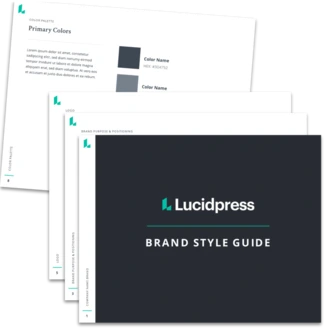When you’re fine-tuning your brand, it’s important for everyone in your company to be on-board.
Let’s face it: Keeping your brand consistent is a tricky task—but it’s one that’s almost impossible if your staff aren’t fully educated about the strong brand you’re trying to create.
Related—Brand building 101: An 8-step brand development strategy
But, how can you keep everyone up to speed with the branding guidelines you’ve put together? In the modern age, when teams are becoming increasingly tech-savvy, an old Word document with a bulleted list of brand elements isn’t the way forward.
There’s one not-so-tiny thing that can help: a brand platform.
Here’s how you can create your own brand platform, and a free template to help you get started.
What is a brand platform?
Acting as the overarching document that includes important details about your business, a brand platform typically includes:
- Your mission statement: What are you hoping to accomplish through the products or services you’re offering?
- Your key values: What do you stand for as a company?
- Your brand’s tone of voice: Do you use slang in your communications with customers or stick to industry jargon?
- Your brand personality guidelines: Are you a fun and friendly brand, or do you talk to your customers professionally?
- Your visual branding elements: Which logos, fonts & colors are you using on your website and marketing collateral?
Every company, no matter what industry they’re operating in, should have a brand platform.
Why do I need a brand platform for my business?
It’s all well and good for me to harp on about brand platforms, but you want to know why this document is so important for businesses, right?
Here’s your answer: This central document helps to make sure everyone in your business is on the same page. From sales and marketing teams to creative departments, your business’s brand platform should be accessible by all employees, and clearly understood before undertaking any new marketing strategy or messaging.
This helps to keep your brand consistent—a tactic that has been proven to influence a 23% increase in revenue, on average.
In short: You’d be foolish to neglect it!
The perfect template for creating a brand platform
While brand platforms are critical, creating a document that is well-received by all members of your team isn’t an easy task.
However, we’ve created this brand platform template to provide inspiration for your own development. Simply open the template in Lucidpress and edit each element to match your brand.

Download this free brand platform template.
3 tips for adding your own identity to this template
Now that you’ve got a template to base your brand platform on, use these three tips to add your own identity.
1. Dig deep into your business’s true values
Certain sections of this template require you to dig deep into the core of your brand—including the mission statement and brand personality sections.
So, avoid filling this section of your template with fluff. Remember: A strong brand has a strong reason behind the things they’re doing.
You could gain valuable insights for this section of your brand platform by:
- Interviewing your CEO or founder to discover why the company started, what problem it was created to solve, and what aim it means to accomplish.
- Asking co-workers why they enjoy working at the company.
- Surveying previous customers to unveil which company value prompted them to purchase.
The latter option is fantastic because you’re able to identify which of your branded elements have worked previously. For example, if you notice an overwhelming number of customers purchased because of your company-wide passion against animal testing, don’t miss out by failing to include this in your brand platform. It’s already proven to be effective.
2. Use your brand platform for every type of marketing activity
Planning to launch a Facebook advertising campaign? Looking to use Google Ads to sell more products? Gearing up to attend an industry trade show?
In any of these occasions, your brand platform is critical.
Why? Because a powerful brand is consistent. Think about it: One of the most recognizable brands in the world is Nike. I’ll bet their signature checkmark logo wouldn’t be as iconic if it wasn’t plastered across their sneakers, website and social media profiles.
So, use this consistency concept when doing any type of marketing activity. Encourage all members of staff to refer back to the brand platform when representing your company, and you’ll be on the road to a strong, powerful brand in no time at all.
3. Don’t try to be something you’re not
Did you know that 94% of all consumers are more likely to be loyal to a brand when they commit to transparency? Attempting to be something you’re not isn’t going to sit well with the people you’re working so hard to win over.
Going back to our tip on digging deep into your brand’s true values, pretending to be something you’re not—and fabricating your values to seem more interesting—shouldn’t be part of your brand platform creation process.
Instead, be true to your brand. Marketing to the beat of your own drum is much better than following the crowd.
Final thoughts on creating a brand platform
Are you ready to make a start on your brand platform and experience the benefits of consistent branding?
That’s great, but don’t let your hard work go to waste.
Make sure every member of your team is fully on-board with your brand platform before publishing any marketing materials—including social media posts, online ads or blog posts.
Whether you’re printing out the template and pinning it to your office wall or holding a company-wide meeting to explain each element, your new brand platform won’t be effective if it’s not being taken seriously. Be the champion your brand platform needs, and you’ll see results in no time.



